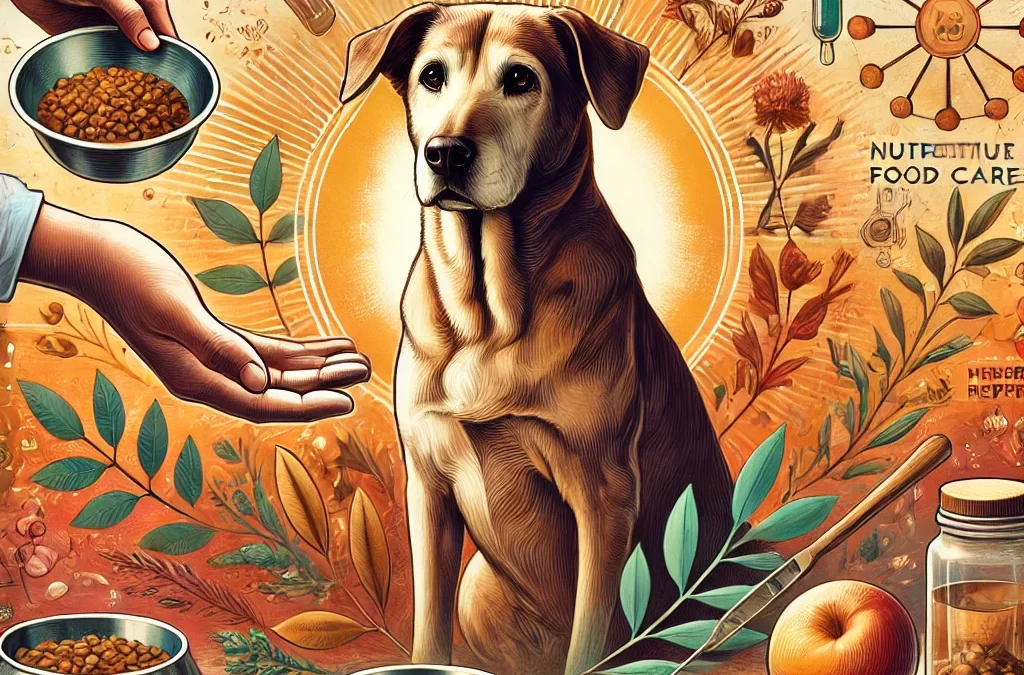
by TCMVET | Dec 18, 2024 | Dog Cancer & Tumors
Introduction: The Silent Enemy in Canine Cancer Care
Cancer cachexia, a complex metabolic syndrome characterized by severe weight loss and muscle wasting, is a silent yet deadly condition affecting many dogs with cancer. Often overshadowed by the primary disease, cachexia significantly impacts the quality of life, response to treatment, and overall survival of affected pets. Understanding and addressing this condition is crucial for holistic cancer care in dogs.
What is Cancer Cachexia?
Cancer cachexia is more than just weight loss. It’s a multifactorial condition driven by the interplay of systemic inflammation, metabolic dysregulation, and the tumor’s metabolic demands. Key features include:
- Loss of Muscle Mass: Unlike simple starvation, cachexia leads to muscle loss that cannot be reversed through increased caloric intake alone.
- Appetite Changes: Dogs may show reduced interest in food (anorexia) or altered taste preferences.
- Systemic Inflammation: Tumor-induced inflammation exacerbates metabolic imbalances, further worsening the condition.
Why Does Cancer Cachexia Occur in Dogs?
The exact mechanisms of cancer cachexia are complex and vary depending on the type and stage of cancer. Factors contributing to this condition include:
- Tumor Metabolism: Certain tumors secrete substances that interfere with normal metabolic processes, causing muscle and fat breakdown.
- Cytokines and Hormones: Increased levels of pro-inflammatory cytokines (e.g., TNF-alpha) and hormonal imbalances play a critical role in driving cachexia.
- Nutritional Deficiencies: Decreased food intake and impaired nutrient absorption worsen the dog’s condition.
Recognizing Cancer Cachexia in Dogs
Early detection is key to managing cancer cachexia. Look for these signs:
- Unexplained weight loss despite adequate food intake
- Muscle wasting, especially around the spine and hind legs
- Fatigue and reduced activity levels
- Changes in appetite or eating behavior
Innovative Management Strategies
While there is no one-size-fits-all solution, a multimodal approach can help manage cachexia in dogs. Here are some emerging strategies:
- Customized Nutritional Support: A diet rich in high-quality proteins, omega-3 fatty acids, and specific amino acids like glutamine can help preserve muscle mass.
- Appetite Stimulants: Medications like mirtazapine or capromorelin may improve appetite and food intake.
- Anti-Inflammatory Therapies: Omega-3 supplements and drugs targeting inflammatory pathways can reduce cytokine activity.
- Metabolic Modulators: Research into drugs like anamorelin and ghrelin mimetics shows promise in reversing muscle wasting.
The Role of Integrative Medicine
Natural therapies, such as Traditional Chinese Medicine (TCM), have shown potential in alleviating symptoms. Herbs like astragalus and ginseng may support immune function and energy levels, while acupuncture can improve appetite and reduce inflammation.
Looking Ahead: The Need for Further Research
Despite progress, cancer cachexia remains under-researched in veterinary medicine. Collaborative efforts between veterinarians, researchers, and pet owners are essential to develop new therapies and improve outcomes for affected dogs.
Conclusion: Hope Through Innovation
While cancer cachexia poses significant challenges, advancements in understanding and managing this condition offer hope. By adopting a holistic and proactive approach, we can improve the quality of life for dogs battling cancer and help them enjoy their golden years with dignity and comfort.
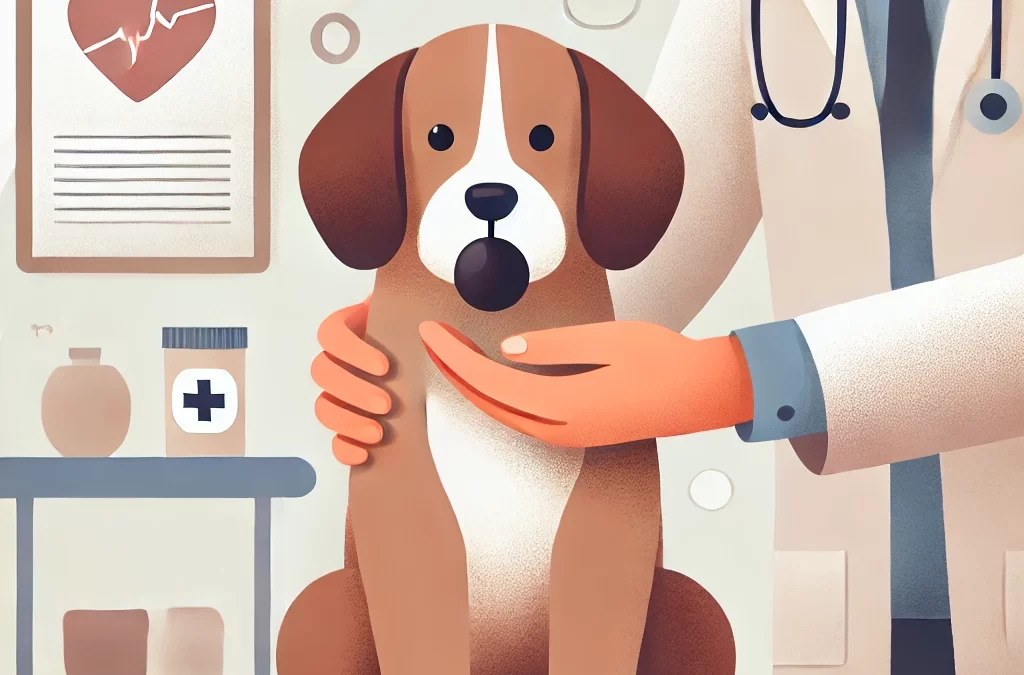
by TCMVET | Dec 16, 2024 | Dog Cancer & Tumors
Oral malignant melanoma (OMM) in dogs is a stealthy adversary. Known for its aggressive nature and rapid spread, it’s a diagnosis that strikes fear into the hearts of pet owners. But OMM is more than just a medical condition—it’s a call to action for pet parents to embrace vigilance, innovation, and holistic care. Let’s dive into this challenging topic with a fresh lens, exploring both science and hope.
What Is Oral Malignant Melanoma?
Oral malignant melanoma is a type of cancer that originates in the melanocytes—cells responsible for pigment production in the skin and mucous membranes. While it most commonly appears in the mouth, this cancer doesn’t stop there. It’s notorious for its ability to invade nearby tissues and metastasize to distant organs like the lungs and lymph nodes.
This condition is most prevalent in middle-aged to older dogs, particularly breeds with dark-pigmented gums, such as Cocker Spaniels, Chow Chows, and Scottish Terriers. Despite its grim reputation, understanding OMM’s signs and treatment options can empower owners to make informed decisions.
Recognizing the Signs
Oral malignant melanoma often goes unnoticed until it’s advanced, making regular oral check-ups critical. Common signs include:
- A dark or irregular mass in the mouth, gums, or lips.
- Bleeding, foul breath, or drooling.
- Difficulty eating, chewing, or swallowing.
- Facial swelling or enlarged lymph nodes.
If you spot any of these symptoms, consult your veterinarian immediately. Early detection can significantly impact outcomes.
Beyond Traditional Treatments: Embracing Innovation
Conventional treatments for OMM include surgery, radiation therapy, and chemotherapy. While effective in many cases, these options aren’t always accessible or affordable. Here are some innovative and integrative approaches gaining attention:
- Immunotherapy Vaccines: A game-changer in oncology, OMM-specific vaccines, like the canine melanoma vaccine (ONCEPT®), stimulate the dog’s immune system to fight cancer cells. This cutting-edge treatment has shown promise in extending survival times.
- Photodynamic Therapy (PDT): This technique uses light-activated drugs to destroy cancer cells selectively, sparing surrounding healthy tissue. It’s a less invasive option for certain cases.
- Holistic Supplements: Natural supplements like curcumin (found in turmeric), medicinal mushrooms, and omega-3 fatty acids are being explored for their anti-inflammatory and immune-boosting properties. Always consult a vet before incorporating supplements.
The Role of Diet in Recovery
A cancer diagnosis calls for a shift in dietary strategies. Dogs battling OMM benefit from a diet tailored to their metabolic needs. Focus on:
- High-quality proteins: Lean meats and fish to maintain muscle mass.
- Healthy fats: Omega-3 fatty acids to combat inflammation and support overall health.
- Low-carbohydrate options: Cancer cells thrive on sugar; limiting carbs can help slow their growth.
Homemade, vet-approved meals can be a great way to ensure your dog receives optimal nutrition.
Emotional and Practical Support for Pet Parents
Caring for a dog with OMM is as emotionally demanding as it is challenging. Here’s how to navigate this journey:
- Create a daily care routine: Establishing consistency can help reduce stress for both you and your dog.
- Seek community support: Online forums and local support groups for pet owners dealing with canine cancer can provide comfort and valuable insights.
- Explore palliative care options: If curative treatment isn’t an option, focus on pain management and improving your dog’s quality of life.
A Glimpse of Hope
While oral malignant melanoma in dogs is a formidable foe, advancements in veterinary medicine and integrative care are changing the narrative. Early detection, innovative treatments, and a focus on holistic well-being are empowering pet parents to fight back against this disease.
Your dog’s diagnosis doesn’t define the journey—it’s a chapter in the story of their resilience, love, and the bond you share. Keep asking questions, seeking solutions, and cherishing every moment.
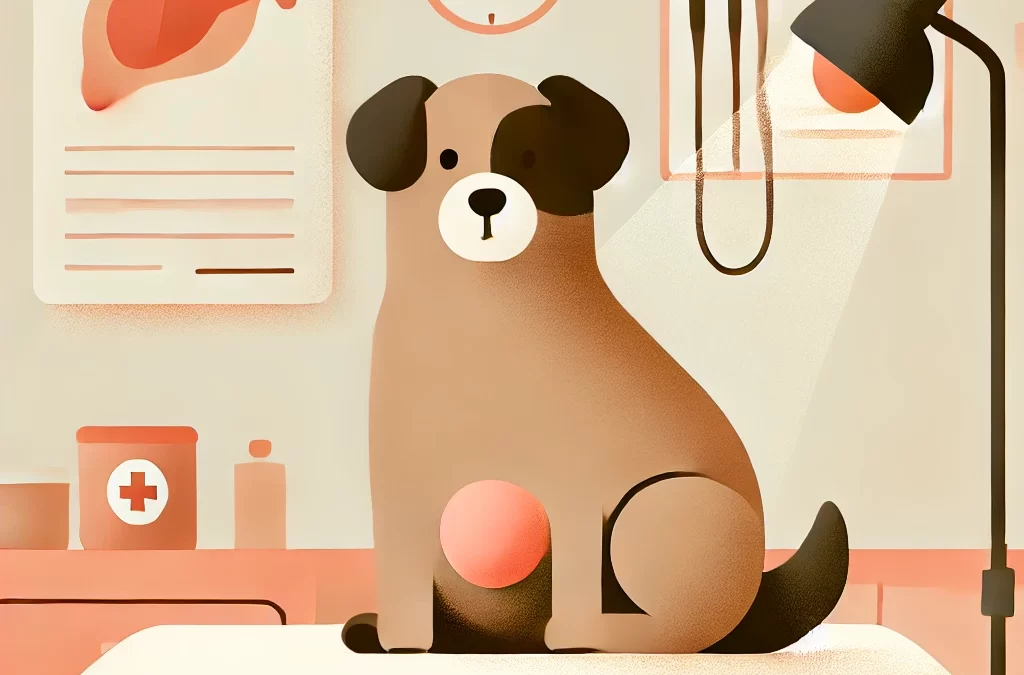
by TCMVET | Dec 16, 2024 | Dog Cancer & Tumors
Discovering a lump on your dog’s stomach can be alarming. As pet owners, our first instinct is often worry—but not all lumps are dangerous. In fact, many are benign and manageable with proper care. To help you navigate this situation, here’s a fresh perspective on understanding, identifying, and addressing stomach lumps in dogs.
What Exactly Is a Stomach Lump?
A stomach lump in dogs refers to any abnormal mass or swelling in the abdominal area. These can vary in size, shape, and texture—some feel soft and movable, while others may be firm or attached to underlying tissues.
The key to handling such lumps lies in observation and timely action. Before jumping to conclusions, let’s explore the most common causes behind these growths.
Common Causes of Stomach Lumps
- Lipomas (Fatty Tumors): These are benign, soft, and slow-growing lumps commonly found in older dogs. Lipomas rarely pose a health risk and are usually more of a cosmetic issue.
- Hematomas or Abscesses: If your dog recently experienced trauma, the lump could be a hematoma (a collection of blood under the skin) or an abscess caused by an infection. These are often warm and tender to the touch.
- Hernias: Hernias occur when internal tissues or organs push through a weak spot in the abdominal wall. They may feel soft and reduce when pressed gently.
- Malignant Tumors: Unfortunately, some lumps are cancerous. Mast cell tumors, soft tissue sarcomas, and other malignancies often require prompt veterinary attention and treatment.
- Cysts or Sebaceous Gland Growths: These are often fluid-filled sacs or clogged glands that can appear on your dog’s stomach. They’re generally harmless but may require draining or minor surgery if they grow too large.
Signs That Require Immediate Attention
While not all stomach lumps are a cause for concern, certain symptoms signal the need for an urgent vet visit:
- The lump grows rapidly in size.
- Your dog appears in pain when the area is touched.
- The lump is hard, immovable, or irregularly shaped.
- There is redness, swelling, or discharge from the area.
- Your dog shows signs of lethargy, appetite loss, or other systemic issues.
What to Do If You Discover a Lump
- Monitor the Lump: Keep track of its size, texture, and behavior. Taking photos every few days can help you note any changes.
- Schedule a Vet Visit: Your veterinarian can perform a physical exam and may recommend diagnostic tests such as a fine-needle aspiration, biopsy, or ultrasound to determine the lump’s nature.
- Consider Treatment Options: Depending on the diagnosis, your vet might suggest observation, medication, surgery, or other therapies. For benign growths like lipomas, treatment may not be necessary unless the lump causes discomfort.
- Explore Natural Remedies (With Vet Approval): For non-malignant growths, some pet owners turn to natural supplements like turmeric, omega-3 fatty acids, or herbal treatments that promote overall immune health. Always consult your vet before introducing any new supplement.
Prevention Tips for a Healthy Dog
- Regular Check-ups: Early detection is key to managing lumps effectively. Regular visits to the vet ensure any changes are addressed promptly.
- Balanced Diet: A nutrient-rich diet can support your dog’s overall health and immunity.
- Maintain a Healthy Weight: Obesity increases the risk of fatty tumors and other health issues. Keep your dog active and at an ideal weight.
- Skin Care: Regular grooming and inspection of your dog’s coat and skin can help you spot abnormalities early.
A Word of Comfort
Not every lump is life-threatening, and advances in veterinary medicine have made diagnosis and treatment more effective than ever. By staying observant and proactive, you can ensure your dog remains happy and healthy.
If you notice a stomach lump, take a deep breath and reach out to your veterinarian. Together, you’ll find the best path forward for your furry companion.
Tags: dog stomach lump, causes of lumps in dogs, dog lump treatment, dog health care, benign tumors in dogs, natural remedies for dogs
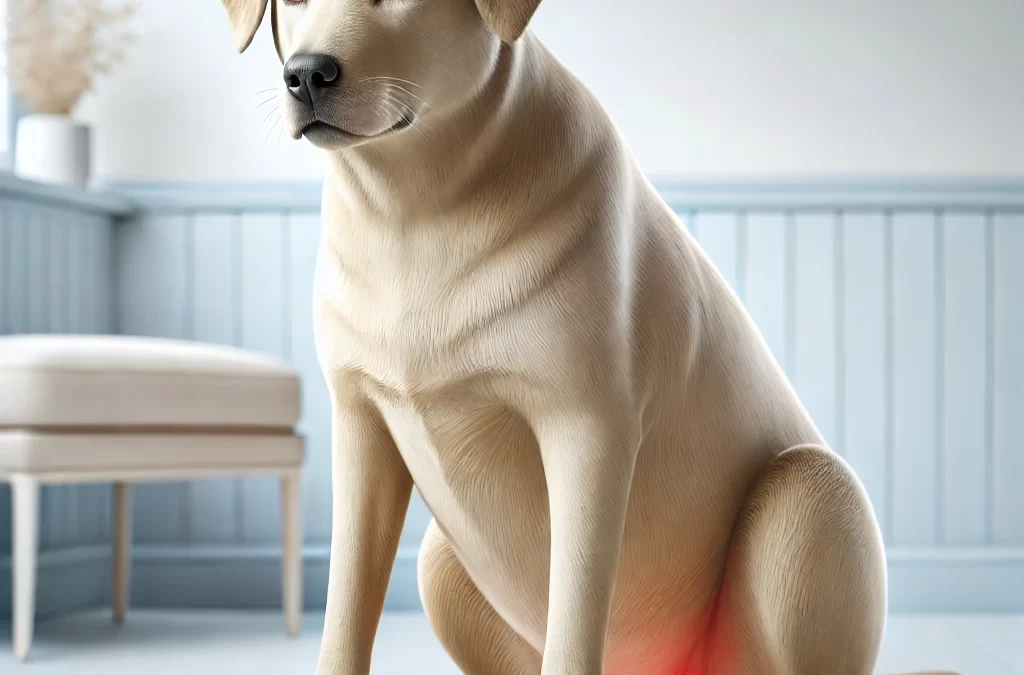
by TCMVET | Dec 14, 2024 | Dog Cancer & Tumors
Abnormal growths in the lower intestines of dogs, though not as common as other health issues, are a concerning phenomenon that often flies under the radar. These growths, which can range from benign polyps to malignant tumors, affect a dog’s digestion, overall comfort, and long-term health. Understanding their causes, signs, and treatment options is crucial for ensuring a better quality of life for your furry companion.
What Are Abnormal Growths in the Lower Intestines?
The term “abnormal growths” encompasses a variety of conditions that affect the lower intestinal tract, which includes the colon, rectum, and anus. These growths might be:
- Polyps: Benign, non-cancerous growths that can cause discomfort but rarely spread.
- Adenocarcinomas: Malignant tumors originating from glandular cells, often aggressive and invasive.
- Leiomyosarcomas: Rare, malignant growths affecting the smooth muscle layer of the intestines.
- Lymphomas: Cancer affecting lymphatic tissues in the intestines, common in dogs with a predisposition to gastrointestinal diseases.
Causes of Lower Intestinal Growths in Dogs
The exact causes vary, but several factors contribute to the development of abnormal growths:
- Age: Older dogs are more prone to intestinal tumors due to cellular aging and mutations.
- Breed Predisposition: Breeds like German Shepherds and Collies have higher risks of gastrointestinal cancers.
- Diet and Environment: Low-quality diets, exposure to toxins, or chronic intestinal irritation can lead to abnormal cell growth.
- Chronic Inflammation: Conditions like inflammatory bowel disease (IBD) create a breeding ground for abnormal growths.
Signs and Symptoms to Watch For
Abnormal growths in the lower intestines often present subtle or ambiguous symptoms, making early detection a challenge. Key signs include:
- Chronic Diarrhea: Persistent loose stools, often with mucus or blood.
- Constipation or Straining: Difficulty passing stool due to obstruction caused by growths.
- Blood in Stool (Hematochezia): Bright red or dark, tarry blood is a common indicator.
- Abdominal Pain: Dogs may display signs like whining, restlessness, or a hunched posture.
- Weight Loss: Unexplained weight loss despite a normal appetite.
- Lethargy and Weakness: A decrease in energy levels due to anemia or systemic effects of the growth.
Diagnosis: Unveiling the Hidden Problem
Diagnosing lower intestinal growths requires a combination of clinical exams and advanced diagnostics:
- Physical Examination: A rectal exam may reveal palpable growths in the lower tract.
- Imaging: X-rays, ultrasounds, or CT scans help visualize tumors and their location.
- Endoscopy: A camera inserted into the colon can identify and sometimes biopsy abnormal tissue.
- Biopsy: Tissue samples confirm whether the growth is benign or malignant, guiding treatment.
Treatment Options: Tailored for Each Case
Treatment varies depending on the type, location, and stage of the growth:
- Surgical Removal: The first-line treatment for localized growths, particularly benign polyps or small malignant tumors.
- Chemotherapy: Recommended for cancers that have metastasized or cannot be fully removed surgically.
- Radiation Therapy: Used in conjunction with surgery for aggressive tumors.
- Palliative Care: Focused on pain management and improving the dog’s comfort in advanced or untreatable cases.
Holistic Support for Digestive Health
While medical treatments address the primary condition, holistic approaches can provide additional support:
- High-Fiber Diets: Promote smoother digestion and reduce irritation in the lower intestines.
- Probiotics: Enhance gut flora and support overall intestinal health.
- Turmeric (Curcumin): Known for its anti-inflammatory and potential anti-cancer properties.
- CBD Oil: Helps reduce inflammation and pain, improving the dog’s quality of life.
Preventive Measures: Reducing the Risk
While not all growths can be prevented, there are steps you can take to lower your dog’s risk:
- Regular Check-ups: Annual veterinary exams help catch abnormalities early.
- High-Quality Diets: Provide balanced, nutritious food to minimize gastrointestinal stress.
- Monitor Stool Health: Keep an eye on changes in your dog’s stool and bowel habits.
- Limit Toxin Exposure: Avoid feeding low-grade food or exposing your dog to harmful chemicals.
The Emotional Toll on Pet Parents
Caring for a dog with intestinal growths can be emotionally draining. It’s natural to feel anxious or overwhelmed, but remember you’re not alone. Many resources, including support groups and veterinary professionals, can guide you through this journey.
Conclusion: Knowledge Is Power
Abnormal growths in the lower intestines of dogs may seem daunting, but with early detection and proactive care, many dogs can lead fulfilling lives. Stay vigilant, seek regular veterinary advice, and provide the best possible care to your four-legged friend.
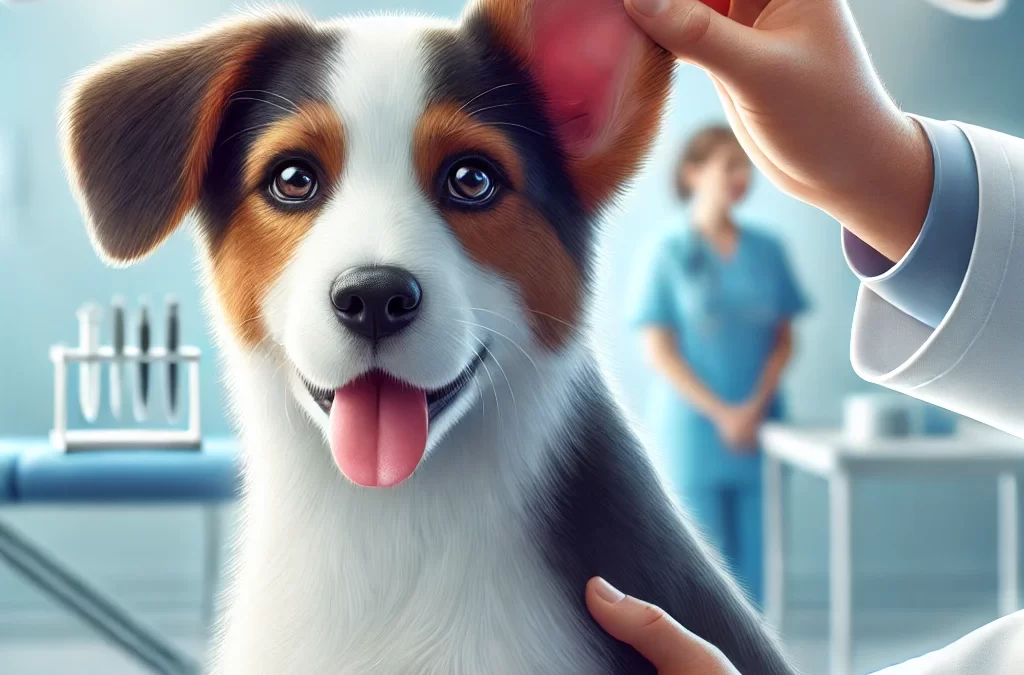
by TCMVET | Dec 14, 2024 | Dog Cancer & Tumors
When it comes to lumps on a dog’s ear, one possibility that often surprises owners is a histiocytoma. These benign growths are common in younger dogs and can appear alarming due to their rapid development and prominent location. However, they’re usually harmless and often resolve on their own. Let’s dive into what makes histiocytomas unique and how you can provide the best care for your furry friend.
What Is a Histiocytoma?
A histiocytoma is a non-cancerous tumor that arises from the Langerhans cells, a type of immune cell found in the skin. These tumors are most commonly seen in dogs under three years of age and typically occur on the head, ears, or limbs.
In the case of the ear, histiocytomas often form on the outer surface or at the edge, creating a visible lump that may concern pet parents. Despite their dramatic appearance, histiocytomas are considered one of the most benign forms of growths in dogs.
Why Do Histiocytomas Occur in Dogs?
The exact cause of histiocytomas is unknown, but they’re thought to be related to an overactive immune response in younger dogs. Breeds such as Boxers, Labradors, and Bulldogs seem to have a higher predisposition, though any breed can develop one.
How to Identify a Histiocytoma on the Ear
Histiocytomas are distinctive in their appearance and behavior, making them relatively easy to spot:
- Appearance: A raised, round, red lump, often hairless and smooth. On the ear, it can look especially pronounced due to the thin skin and lack of fur.
- Size: Typically small, around 0.5 to 2 cm in diameter.
- Texture: Firm to the touch, with a slightly ulcerated or shiny surface.
- Behavior: Unlike malignant tumors, histiocytomas don’t usually cause discomfort unless they’re scratched or infected.
Should You Be Concerned?
One of the most reassuring aspects of histiocytomas is that they’re self-limiting, meaning they often disappear without intervention within 2 to 3 months. However, veterinary consultation is crucial to confirm the diagnosis and rule out more serious conditions such as:
- Mast cell tumors
- Squamous cell carcinoma
- Ear infections or abscesses
What to Expect During Diagnosis
Veterinarians typically use the following methods to identify a histiocytoma:
- Physical Examination: A detailed inspection of the lump and overall health of the dog.
- Fine Needle Aspiration (FNA): A small sample of cells is extracted for microscopic analysis.
- Biopsy: In rare cases, a biopsy may be performed for further confirmation.
Treatment and Care Options
Most histiocytomas resolve on their own, but certain cases may require intervention:
- No Treatment Needed: If the lump isn’t bothering the dog, it can be left alone to regress naturally.
- Surgical Removal: In rare cases where the growth causes irritation or is slow to heal, a veterinarian may recommend removal.
- Topical Treatments: If the histiocytoma becomes ulcerated, antibiotic creams or sprays can prevent infection.
Home Care Tips
While waiting for the histiocytoma to resolve, there are steps you can take to ensure your dog remains comfortable:
- Prevent Scratching: Use an Elizabethan collar if your dog scratches the ear excessively, as this can lead to bleeding or infection.
- Monitor the Growth: Keep an eye on the size, color, and texture of the lump. Rapid changes may warrant a follow-up visit.
- Clean the Area: Gently clean the ear with a vet-recommended solution to reduce the risk of secondary infections.
How Is an Ear Histiocytoma Different?
Histiocytomas on the ear can be more noticeable due to the ear’s sensitive location. They may cause the ear to look asymmetrical or floppy, and dogs might shake their heads more frequently. These specific signs make monitoring and care even more important.
A Natural Approach to Supporting Your Dog’s Healing
Some pet owners explore natural therapies to complement traditional veterinary care. While these methods are not a cure, they can support overall skin health:
- Omega-3 Fatty Acids: Promote a healthy immune response and reduce inflammation.
- Calendula Cream: A soothing herbal remedy to ease irritation around the lump.
- CBD Oil: May help reduce scratching and stress associated with discomfort.
When to Seek Veterinary Advice
Even though histiocytomas are benign, consult your vet if you notice:
- The lump growing rapidly or changing in texture.
- Persistent scratching, bleeding, or discharge.
- The histiocytoma not regressing after 3 months.
Final Thoughts
A histiocytoma on your dog’s ear might seem concerning at first glance, but it’s typically a harmless condition that resolves with little to no intervention. By understanding its unique nature and providing attentive care, you can ensure your dog remains happy and healthy throughout the process.






